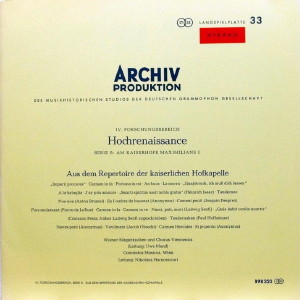 |
1 LP -
198 323 - (p) 1964
|
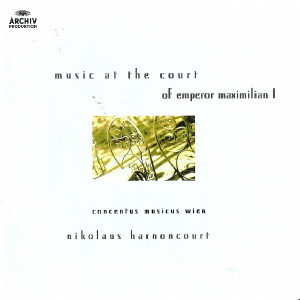 |
| 1 CD -
474 233-2 - (p) & (c) 2003 |
|
Hochrenaissance
- Aus dem Repertoire der kaiserlichen
Hofkapelle
|
|
|
|
|
|
|
|
| - Henricus Isaac
(c.1450/55-1517) - Imperii proceres |
5'
13" |
|
A1
|
- Henricus Isaac -
Carmen in fa
|
1'
17" |
|
A2
|
- Henricus Isaac -
Fortuna in mi
|
2'
39" |
|
A3
|
| - Henricus Isaac - Au
buos |
0'
59" |
|
A4
|
| - Henricus Isaac - La
morra |
1'
24" |
|
A5
|
| - Henricus Isaac -
Innsbruck, ich muss dich lassen |
3'
17" |
|
A6
|
| - Henricus Isaac - A la
bataglia |
4'
00" |
|
A7
|
| - Henricus Isaac - J'ay
pris amours |
1'
50" |
|
A8
|
| - Henricus Isaac -
Sancti spiritus assit nobis gratia |
3'
00" |
|
A9
|
| - Antoine Brumel
(c.1460-1512/13) - Tandernac |
2'
04" |
|
B1
|
| - Antoine Brumel - Noe,
noe, noe |
1'
17" |
|
B2
|
| - Anonymous - En l'ombre
du busonet |
1'
41" |
|
B3
|
| - Josquin Desprez (c.1440/55-1521)
- Coment peult |
1'
35" |
|
B4
|
| - Pierre de la Rue
(c.1460-1518) - Fors seulement |
2'
12" |
|
B5
|
| - Ludwig Senfl
(c.1490-c.1555) - Carmen in la |
1'
05" |
|
B6
|
| - Ludwig Senfl - Carmen
in re |
1'
42" |
|
B7
|
| - Ludwig Senfl - Nasci,
pati, mori |
1'
42" |
|
B8
|
| - Costanzo Festa
(c.1485/90-1545) - Quis dabit oculis
nostri |
5'
01" |
|
B9
|
| - Paul Hofhaimer
(c.1459-c.1537) - Tandernaken |
3'
22" |
|
B10
|
| - Anonymous - Naves pont |
1'
05" |
|
B11
|
| - Jacob Obrecht
(1450-1505) - Vavilment |
2'
09" |
|
B12
|
| - Anonymous - Carmen
Hercules |
1'
19" |
|
B13
|
| - Anonymous - Si je
perdu |
1'
08" |
|
B14
|
|
|
|
|
Bonus tracks in only CD
re-released:
|
|
|
|
| - Henricus Isaac -
Guretzsch (Si dormiero) |
3'
18" |
|
|
| - Henricus Isaac -
Fortuna desperata |
1'
34" |
|
|
| - Henricus Isaac -
Fortuna in mi |
2'
34" |
|
|
|
|
|
|
Wiener
Sängerknaben - Chorus Viennensis
/ Uwe Mund, leitung
|
|
| Concentus
Musicus Wien |
|
|
| - Alice Harnoncourt,
Pardessus de viole, Bratsche,
Regal |
- Leopold Stastny,
Renaissance-Blockflöten in f' und
Schlagzeug |
|
| -
Kurt Theiner, Tenorgeige |
-
Josef Rohm, Altposaune
|
|
-
Nikolaus Harnoncourt, Tenorfidel,
Baßgambe
|
-
Hans Pöttler, Tenorposaune |
|
| -
Hermann Höbarth, Baßfidel
|
-
Andreas Wenth, Baßposaune
|
|
| -
Jürg Schaeftlein, Renaissance-Blockflöten
in c', g' und c" |
-
Georg Fischer, Positiv
|
|
| Nikolaus
Harnoncourt, leitung |
|
|
|
Luogo e data
di registrazione
|
Musikhalle der Wien-Film
G.m.b.H., Vienna (Austria) - 29 aprile /
4 maggio 1963
|
|
Registrazione
live / studio
|
| studio |
Producer / Engineer
|
Hans Hickmann / Harald Baudis
|
Prima Edizione
CD
|
Archiv Produktion "Blue" - 474
233-2 - (1 cd) - 57' 51" (p) & (c)
2003 - ADD
|
Prima
Edizione LP
|
Archiv Produktion - 198 323 -
(1 lp) - 49' 37" - (p) 1964
|
Note
|
-
|
|
|
At the Imperial Court of
Maximilian I - From the Reportoire of
the Imperial Court Chapel
|
The Emperor Maximilian I
(1459-1519), one ot the most famous
figures in European history, lived at a
time ot violent change, which was
impressively symbolized in his character
and life. He was virtually an embodiment
of the spiritual situation of that
epoch: a man of medieval, chivalrous
ideals, and at the same time a man of
the new age in his patronage of science,
humanism and the arts.
In 1477 the young Maximilian was married
to Maria of Burgundy, the daughter and
heiress of Charles the Bold. Burgundy
was the last centre of medieval culture.
At that most brilliant court in Europe
Maximilian became acquainted with the
most eminent artists, heard the works of
Netherlands composers sung and played by
the best musicians of the time. There
his love of music developed into
profound knowledge, and he gained the
experience of music and musicians which
he was later to put to such good use in
the foundation of his own court musical
establishment. This establishment was,
deservedly, the object of widespread
admiration. The music ot Maximilian's
court gave the decisive impulse to the
dawning musical culture of Germany.
The contrasts of that transitional
period are emphasized by a clear
distinction between north and south: in
Italy, the birthplace of the
Renaissance, the spiritual
transformation had taken place more
completely than in the northern
countries. The visual arts had cast off
all "Gothic" (considered at that time to
be tantamount to barbaric) forms, had
discovered secular impulses. This land
was bound to appear to many, especially
artists north of the Alps who still
lived and worked largely in the spirit
and forms of the middle ages, as a
shining example. In order to point out
the widely differlng forms existing at
the same time it is sufficient to
mention a few of the foremost artists of
that period: Adam Krafft, Tilman
Rlemenschneider, Mathls Nithart, known
as Grünewald as representatives of the
late Gothic spirit, while Leonardo da
Vinci, Michelangelo and Raphael were at
work in Italy. Albrecht Dürer, who was
closely connected with Maximilian for a
time, was the first German artist to
make the new ideals his own, following
several artistic pllgrimages to Italy.
In music the different epochs were less
clearly differentiated, but here, too,
the two faces of art at that time are
distinguishable. The composers of the
generation of Isaac and Josquin went a
way which led from the rhythmical and
tonal diversity of the earlier
Netherlands masters to the noble suavity
of the classically polyphonic, imitative
textures of the 16th century. It is
noteworthy that although this change was
brought about by Netherlands composers,
they were all men who had lived in
Italy, the land of the new art.
The outstanding composer ot the circle
around Maximilian was Heinrich Isaac.
The Emperor had engaged this Flemish
musician, who had previously been
employed at the Medici court in
Florence, as his court composer in 1495.
Isaac was required to provide
compositions, but he was permitted to
continue living in Florence, and to keep
up his contacts with other patrons.
Naturally he had to visit the Imperial
court from time to time at the Emperor's
command. Isaac's musical versatility has
often been praised. While he tended
towards conservatism in tonal and
harmonic respects, favouring harsh
fifths and the complex rhythms of the
early Netherlands masters, he was highly
inventive in matters of form. A great
deal of his instrumental music has
survived. One particularly interesting
piece is the Bataglia. In this dark
music we find tone painting of a kind
which was then new: in addition to
battle cries and trumpets we can hear
painful lamentation and the typical
rhythms of galloping horses - all these
elements were to appear regularly in
later musical battle pictures. The two
Latin homage motets were probably
composed during the winter of 1507/O8 in
connection with the Reichstag at
Constance.
The only personal pupil of Isaac known
to us was Ludwig Senfl,
who came from Zürich, When Isaac died
Senfl succeeded him as court composer to
Maximilian. While his songs aim at
complete euphony, his instrumental
pieces, in which he frequently set
himself complex contrapuntal tasks, are
reminiscent of the harsher tonal world
of his teacher. - The Motet "Quis dabit
oculis nostris", lamenting the death of
Maximilian, has been wrongly attributed
to Senfl ever since Ott published it
under his name in 1538 (see Denkmäler
deutscher Tonkunst, Zweite Folge
[Denkmäler der Tonkunst in Bayern], Jg.
3, Bd. 2: Ludwig Senfls Werke, Erster
Teil, ed. by Theodor Kroyer, Leipzig
1903, p. XXXV, and Theodor Kroyer,
Ludwig Senfl und sein Motettenstil,
Munich 1902, pp 20-21); in fact,
according to the Codex Bologna,
Biblioteca Musicale Martini, Ms. Q 19
ff., 76-78, printed in: Monumenta
polyphoniae italicae II, Rome 1936, pp.
108-112., it was composed by Costanzo
Festa, and its original text
related to the death of Queen Anne of
France (1514). - Anton Brumel
was also among the internationally
recognized masters of his generation.
His instrumental piece based on the
wellknown song "Tandernac" (To
Andernach) is full of wild rhythmical
audacities such as were no longer
customary at that time. - Pierre de
LaRue was closely connected with
the Imperial family. From 1492 onwards
he was employed at Maximilian's
Burgundian court. LaRue was the
romanticist of the age. A work typical
of his almost impressionistic style is
"Fors seulement". - Jacob
Obrecht was active in
various towns of Flanders throughout
almost all his lifetime. It may be
assumed that Maximilian, during his
Burgundian period, became acquainted
with this renowned composer.
The most famous organist ot the period
was Paul Hofhaimer.
Paracelsus once said: "What Hofhaimer is
at the organ, Dürer is in painting." -
As the organ was primarily an instrument
for improvisation, few of Hofhaimer's
organ pieces have come down to us. One
ot these is "Tandernaken", an
arrangement of the song which formed the
basis of many instrumental pieces. This
work has survlved in a tablature
notation by his pupil Kotter; in
addition to the customary three voices a
fourth is noted, with the remark "to be
played by another person". Surprisingly
enough it is not the Cantus firmus, the
song melody, which is thus to be played
by a different musician for greater
emphasis, but a richly decorated altus
part, which was evidently composed as an
after-thought. The distinctive character
of this figured part makes it clear that
the well-known Cantus firmus was merely
the starting-point for the composition
and not its principal voice. The altus
part should evidently be kept clearly
separate from the other moving parts.
In several of the works here recorded we
can sense the growing attempt to achieve
clearly established form. Thus, for
example, the return of the opening motif
at the end of lsaac's "Carmen in fa" and
"An buos", and such homophonic
concluding sections as those of the
anonymous "Si je perdu" or Obrecht's
"Vavilment" were intended to provide a
clear final effect, Other works still
lack this formal element of
construction. The earlier ideal - that
music should commence apparently without
any definite beginning, and fade out
without a clear ending, as though it
could go on for ever - is still evident
in certain of the compositions, such as
the anonymous "Hercules", or Brumel's
"Tandernac".
Notes on performances and
instrumentation
Unfortunately little is known for
certain about the performing
practice applicable to this music,
so that we frequently have to resort
to hypothesis, and more frequently
still have to rely on our musical
feeling. The most important problems
are: 1. the accidentals to be added,
2. the instrumentation, and 3. the
improvisation. 1. in order to avoid
destroying the modal richness of the
music, accidentals have been added
only where this appeared to be
absolutely necessary. The transition
from modal to tonal writing (i. e,
from the old Church tones to the
major and minor system) is one of
the criteria distinguishing the
older music of the Netherlands
school from music in the style of
Palestrina. 2. It is known from
paintings what instruments were
played at that time. In choosing the
instrumentation for the individual
pieces particular attention was
devoted to the performing technique
and characteristics of the
instruments, and to the tonal
effects of various instrumental
combinations. Some figures are
typical of wind instruments, some of
strings. - Many of the instrumental
pieces bear titles which point to
vocal music. At that time there were
as yet no hard and fast boundaries
between the spheres of vocal and
instrumental music. Instrumental
pieces were seldom composed as such;
musicians adapted vocal pieces for
their instruments (organ and lute
tablatures), both modes of
performance being equally possible
and correct. In the sources here
drawn upon all the instrumental
pieces are without text. 3. While
considerable scope was allowed for
improvisation in the music of that
era, this was true principally of
such music as was never written
down. ln music which was in fact set
down even ornamentation was written
out, and in this recording only a
few trills and mordents have been
added. We possess many proofs that
percussion instruments were used,
but as no parts were ever written
from them these have had to be
added. Every modern interpretation
of this music represents only one of
many possibilities. Naturally limits
are set to the musician's
imagination; the knowledge and
stylistic feeling of the interpreter
must produce the most satisfactory
union of effect possible. - People
ot that period were passionate,
vital, strong in their expressions
of joy and grief. It is impossible
to imagine their music being played
in an "objective" manner. However
the music of those days was
interpreted, the contemporaries of
Grünewald and Dürer certainly
neither performed nor listened to
music in a dry and unconcerned
manner.
The instruments employed
The earliest existing string
instruments are distinguished by a
tone of splendid velvety quality.
Such instruments cannot be rebuilt
satisfactorily. Fortunately we
possess two Italian instruments
which belong to the fiddle class,
and whose tone fulfils all our
requirements. The bass fiddle of
1558 is from the instrumental
collection of the Damenstift at
Hall, one of the most important
musical foundations of the 16th
century. In the case of this
instrument we know the name of its
maker (a very rare occurrence for
that period), and also the names of
all its owners down to the present
day. It was probably the private
property of the Archduchess
Magdalena, daughter of the Emperor
Ferdinand I, who founded the
Damenstift at Hall in 1569, taking
her musical instruments with her.
This instrument is unique. The tenor
fiddle is unsigned, but its
construction corresponds so
completelz to that of the bass
fiddle, that they must be products
of the same school, if not of the
same maker. These two instruments
were taken as the tonal models for
the selection of the remaining
instruments. It was established that
the viols and tenor viol of the
baroque age are considerably nearer
to the earlier tonal ideal than any
moodern reconstructions of fiddles.
The recorders are exact copies of
surviving instruments in the Ambras
collection. Each one was made in one
piece of wood.
Two of the trombonns are copies, one
is un original instrument dating
from around 1700. As tho
construction of the trombone, and
therefore also its tone, did not
alter from its introduction around
1400 until the middle of the 18th
century, we have a guarantee here,
too,of an authentic sound-pattern.
The organ probably dates from the
l7th century, but, as is often the
case with English instruments, its
specification corresponds to that of
far older organs. It possesses three
registers,a1l with wooden pipes:
Gedackt 8', Open 4' (Principal),
Zimbel.
- Pardessus de viole
(Ludovicus Guersan, Paris 1742)
- Bratsche (Matthias
Thier, Wien 1806)
- Regal (Johannes
Koch, Kassel 1962; Rekonstruktion nach
Michael Praetorius: Syntagma musicum,
Wolfenbüttel 1615-1620
- Tenorgeige
(Marcellus Hollmayr, Wien 17. Jh.)
- Tenorfidel (aus
Oberitalien um 1550)
- Baßgambe (Jacon
Precheisn, Wien 1670)
- Baßfidel (Stefanus
de Fantis, Oberitalien 1558)
-
Renaissance-Blockflöten in c', f' g'
und c" (Martin Skowroneck, Bremen
1960; nach Originalen aus dem 16. Jh.
im Wiener Kunsthistorischen Museum und
Schlagzeug)
- Altposaune
(Antoc Čiek, Wien 1941; nach M.
Leichamschneider, Wien um 1720)
-
Tenorposaune (Friedrich Ehe,
Nürnberg um 1700)
-
Baßposaune (Mitte des 19. Jh.; nach
M.
Leichamschneider, Wien um 1720)
- Positiv (N. Smith,
England, um 1670)
Nikolaus
Harnoncourt, 1964
|
|
Other Editions
|
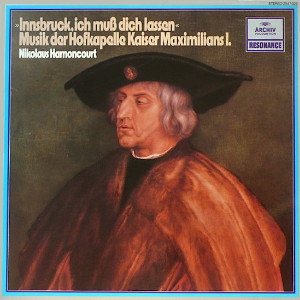 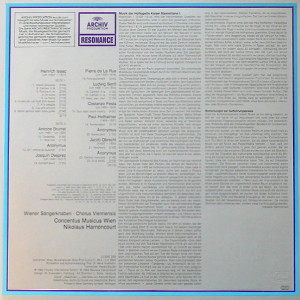 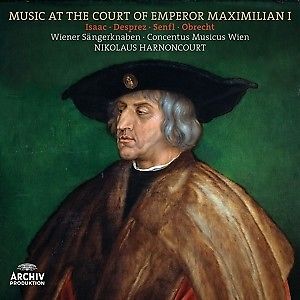 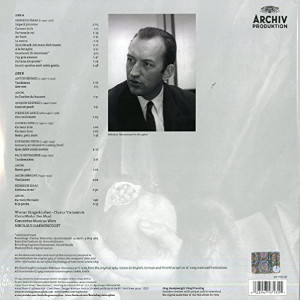 |
- Archiv
Produktion "Resonance" - 2547 029 - 1 LP -
(c) 19??
- Archiv Produktion - 479 7135 - 1 LP (180
gr.) - (c) 2017 (Limited Edition)
|
|
|
|
Nikolaus
Harnoncourt (1929-2016)
|

|

|
|